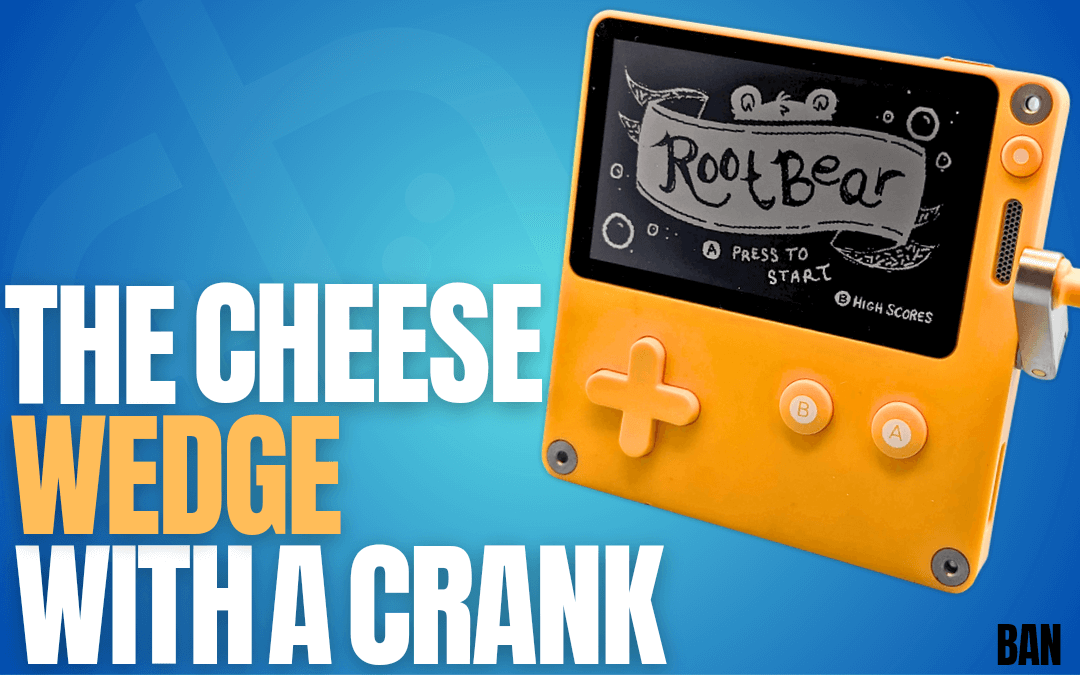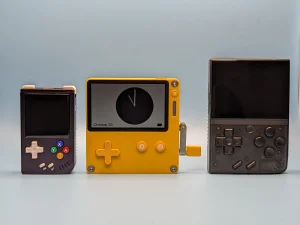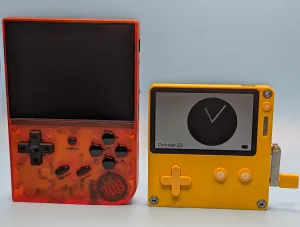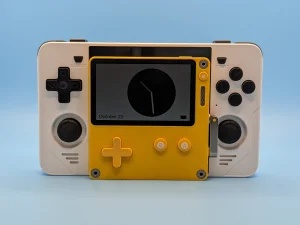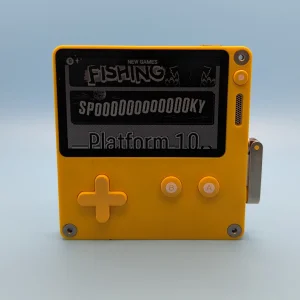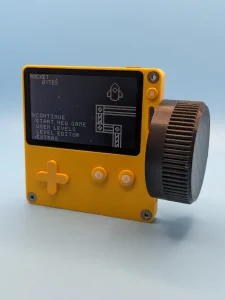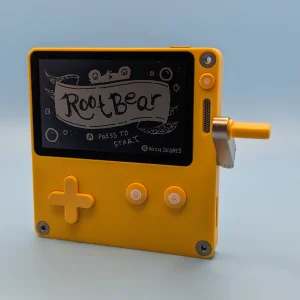Do you enjoy the niche world of handhelds that don’t run off of emulation using Rockchip processors? Do you like pre-ordering a handheld in 2021 with the possibility of receiving it within a year, only to find out you’re going to receive it even later as in 2023? What if you chose to wait it out only to find that, not only are the pre-orders still around as of 2023, but the price of the product has also gone up since it was originally announced? That’s right! I’m… not talking about the Analogue Pocket. They actually started shipping more “ready to ship” products (albeit limited edition). In this review we’re going to be talking about the Playdate: the little yellow console with a crank.
Oh and before we get into it. I just want to say my Playdate unit was bought second hand on the Retro Handhelds Discord (Thanks Jim!) and all of the thoughts and (poor) opinions are my own.
What is the Playdate?
When it comes to the Playdate, you need to know where it comes from; Panic. Panic, founded in 1997, originally published Mac applications for developers until they published Firewatch in 2016 and Untitled Goose Game in 2019. After that, they have become a game and software company who decided to develop and release a little yellow console as a celebration of how far they’ve come, and that’s the Playdate. With it came a lot of its own struggles along the way. You can find out more in the Playdate Podcast. Highly recommended.
So what is the Playdate? It’s a tiny vertical console, powered by an single core STM32F746, with 16mb of ram, and 4GB of storage to store all the games made specifically for this device (which can be downloaded over Wi-fi on the console itself). All of this GRUNT powered by a 650mAh battery, running a non-backlit, 2.7 inch 400×240 LCD screen. This isn’t a lot of handheld, and the controls show just as much. One D-pad, Two Face buttons, a lock-button up top, and the wonderful little metal crank along the side. All of this can be charged by the USB-C Port on the bottom and you can listen through bluetooth, the front facing speaker, or the 3.5mm jack on the bottom (take that Apple.. again!).
Size Comparison
When it comes to size, I would mostly compare the Playdate to 3 to 4 slices of American cheese stacked on top of one another. You’re sure to have that for a comparison at home right?.. Just me?
![]()
If not, I’d also compare it to something like the Anbernic RG Nano. The Playdate is only slightly taller, however it’s also about 2 Nanos wide and only slightly taller.
The Miyoo Mini OG on the other hand is a little bit taller, quite a bit more narrower, and over twice as thick when compared to the Playdate. At this size it means the Playdate is dwarfed by even smaller 3.5 inch devices like the R35S or RG35XX.
If you want to go off of the rails, you can compare the Playdate to something the size of an Ayn Odin. If you thought the the Playdate was dwarfed before, now it isn’t much larger than one side of controls on the Odin. Or if you’d prefer something more reasonable and easy to explain. The Playdate fits nicely within the screen and bezel of a device like the RGB30.
Oh and in case you’re curious about the weight, here are the devices I’ve talked about listed from lightest to heaviest.
RG Nano: 75 grams
Playdate: 84 grams
Miyoo Mini: 106 grams
R35S: 169 grams
RG35XX: 175 grams
RGB30 : 208 Grams
Ayn Odin: 376 Grams
A shrunk down size seems to only affect D-pad which is smaller than most other handhelds, but the face buttons are all quite a nice size. The crank on my unit, pops out nicely, turns smoothly and disappears with ease. My biggest gripe with the buttons is just how clicky they end up being. Little travel, more click than a Retroid Pocket 1, it’s just a bit of an odd experience but one you can get used to.
Software Experience
With Panic being a primarily Mac based software developer, you can only assume how good the Playdate software is. And in all honesty… it’s really good. When the device is locked it shows you a clock (Analog, Digital, or Word-based), the date, and your battery life. Once unlocked you’re greeted by all of your games as well as the app for Catalog, and Settings. Clicking on any of these immediately boots you into the specific app. And if that isn’t enough for you, pressing the little function button above the speaker opens the side menu, which lets you change volume, access settings and catalog, as well as take a screenshot. In Card mode, everything is nicely designed and easily viewable. List mode is simple, organized, and personally easier to read. In just a few words on the Playdate OS; Simple, Straightforward. Everything you’d need, nothing you don’t. I wish more devices would have a visual system that was as nice to use as this, but at that same time… who’s going to use a 400×240 Monochrome display for their devices?
The Gaming Experience
Let’s get to what you really want to know; Gaming. Can it run the latest Spider-Man 2 at 4K 120FPS, Ultra Hi-definition settings with ray-tracing enabled? No. The Playdate can’t even emulate Gameboy at full speed. The Playdate was built to play Playdate games. Period. That’s not a bad thing! There’s a whole ecosystem for this system that I want to get into, starting with the Season 1 games and the Catalog for Playdate.
Official Gaming
All Playdate consoles came with what is known as Season 1 games for free. Season 1 consists of 24 different games with different styles that were released to the console, 2 at a time, every week until you received all of them. I don’t want to talk about everything for fear of spoiling it, but I’d like to share a couple of my favorites and the experience I had with them.
Omaze. A Puzzle platformer that utilizes the crank to help solve your circular puzzles and mysteries. The crank, as always on the Playdate, moved smoothly and pretty much never had any false inputs for me. Executive Golf DX, a… well, a golfing game that needed precise aim to get where you needed to go. I had the choice of the Crank and D-pad for aiming, and my gripes with the clicky d-pad left me wanting to go back to the crank, which felt like a much nicer tool for this one. And lastly b360. An old game brought back by Panic that’s a starship traversing the galaxy breaking one brick at a time. If you want to hear more about any of these games, again; Panic Playdate Podcast, lovely stuff.
Outside of Season 1, Panic also introduced the Catalog; a shop built into the Playdate that would let you download games on the system (though you need to add a card through their website). My favorites of which included Reel Steel, and A Joke that’s Worth $0.99 (for $1). Both of these games requiring use of the crank, and just a little use from the face buttons. The Catalog itself is currently small; featuring just 90 games. The downloads themselves can take a while as the Playdate only has Wi-Fi N. But with games mostly being under 100mb, it really isn’t awful. But if you want more games you have one more option.
Sideloading
Sideloading is done through the Playdate account website. All you do is choose your Playdate Game file, upload it, and select Download on your Playdate console, and BOOM. New Games. The best place to get games for the Playdate is currently Itch.io (which has 619 tagged games available). Of which my recommendations to you (take them) include Root Bear; a cranking arcade game to get the perfect amount of Root Beer. And Rocket Bytes, another cranking game where you pilot your spaceship between obstacles to the end (think Pulstar.io). With 24 Season 1 games, 90 Catalog games, and 619 and counting homebrew games, you’ll like need a while before you run out of options.
Final Thoughts
So, let’s review. When it comes to use and my opinion? The screen feels seriously sharp and responsive for its size, but being non-backlit means that my use of it indoors at night in bed are very limited. Think of it like needing a worm light for a Gameboy. Notice how my favorite games use the crank? I really am not a fan of the clicky, not quite responsive enough d-pad. But the face buttons are fine for use! The battery itself lasts nicely while playing, up to 8 hours though I haven’t drained it fully yet (and up to 14 days in clock mode WOWEE). Oh- and Audio. It has it. The speaker is front firing, my unit gets loud enough though I’d probably use the headphone jack for the best experience.
With all that being said. Do I recommend the Playdate? For its Pre-order price of $179 $199 or $219 with the cover… plus their Analogue Pocket levels of shipping. I’m not sure if I can recommend it. I absolutely adore the novelty of the machine, and if you know what you’re getting into, or if you want to code games using the Playdate SDK, or Pulp- go for it! But if you just want to experience the device; first hold 3 to 4 slices of cheese (preferably Kraft Singles) in your hands and imagine playing Tetris on it. Done? Now make the screen smaller, and know you can’t see it in the dark. Do you want this kind of indie experience for $199 plus whatever shipping is? Maybe. But I’m not sure if I would. A better indie value might lie back in that Rockchip discussion. Grab an RGB30 for $90, pick up a copy of Pico-8 for $15. Boom you have a massive indie library of simple games for just $105… a much better value if you ask me.
The Playdate is a great little device marred by high prices and long wait times. No matter how great it is when it arrives the Pocket might really be its closest analog yet.
Pre-Order the Playdate Directly from Panic. (Shipping at the end of 2023)
What did you think of this article? Let us know in the comments below, and chat with us in our Discord!
This page may contain affiliate links, by purchasing something through a link, Retro Handhelds may earn a small commission on the sale at no additional cost to you.
